We've spent the last few weeks looking at the program history and technical details of the F/A-18 Hornet family, but that overlooks a third aspect of the story, the airplane's service record both with the US and outside of it.
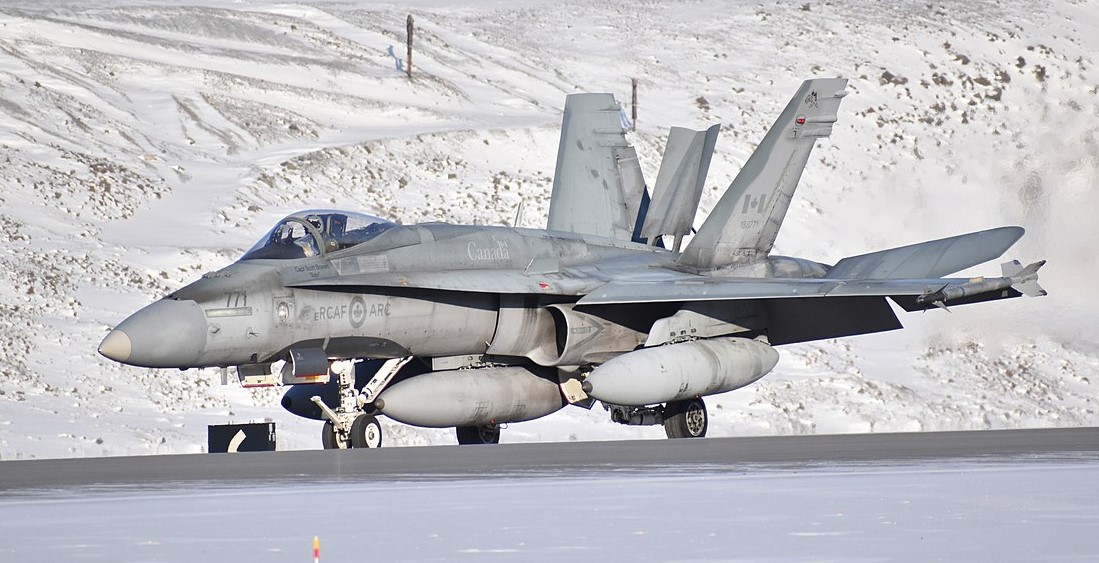
A CF-188A in a typically Canadian environment
Even as the Hornet was just beginning to enter service with the US, it was starting to rack up export orders. Initially, the plan had been for Northrop, who had built the YF-17, to handle those for land-based air forces with the F-18L, customer concerns over buying a design that wasn't actually in production and aggressive salesmanship by McDonnell Douglas saw the carrier-based version selected by a number of nations. The first buyer was Canada, who purchased 96 CF-188As and 40 CF-188Bs starting in 1980. These were used to replace a number of older aircraft, and remain the mainstay of the RCAF today, after several attempts to replace them with F-35s have failed. Hopefully, the most recent decision for the JSF sticks.
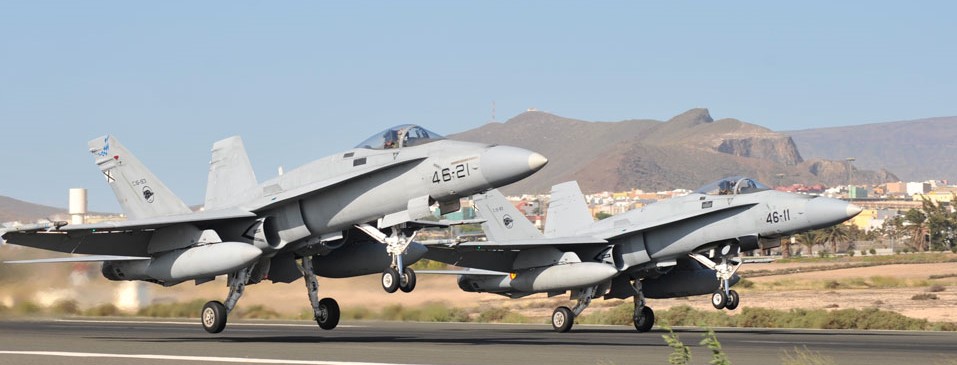
Spanish Hornets scramble
The next year, Australia joined the Hornet family, buying 57 A and 18 B models. The Hornet's twin engines and relatively long range for a land fighter appear to have been decisive, and some of the jets, which were assembled in Australia, remained in service until 2021, when Australia finally retired the last of their Legacy Hornets. Spain was the last early customer, buying 60 A and 12 B models in 1983. These fighters have given good service over the last 35 years, but are currently being replaced by the Eurofighter Typhoon.
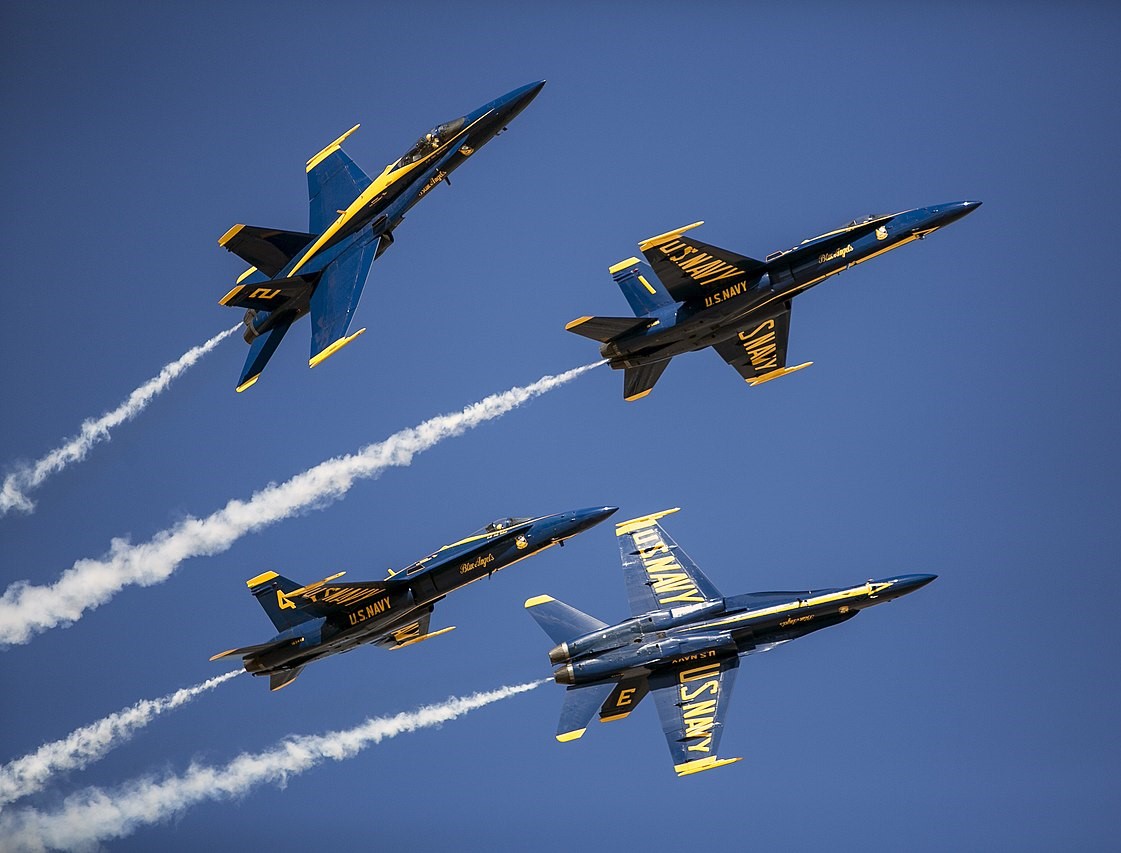
The Blue Angles perform in F/A-18Cs
These customers bought an untested fighter, but later export customers would buy a combat-proven airplane. In 1986, squadrons flying from Coral Sea1 took part in strikes on Libya in retaliation for Gaddafi's support for terrorism. During these strikes, the Hornets helped destroy Libya's air defenses, and managed to avoid losing a single aircraft. That same year, the Hornet was selected for its most visible role, replacing the A-4 Skyhawks that the Blue Angels had been operating. The Blue Angels would fly the Legacy Hornet for a total of 34 seasons, before trading them in for Super Hornets, the last USN unit to do so. The aircraft they fly are generally among the oldest in the fleet, and have most of their combat systems (including the gun and radar) removed. The flight computer is modified, and smoke generators and civilian navigation aids are installed.
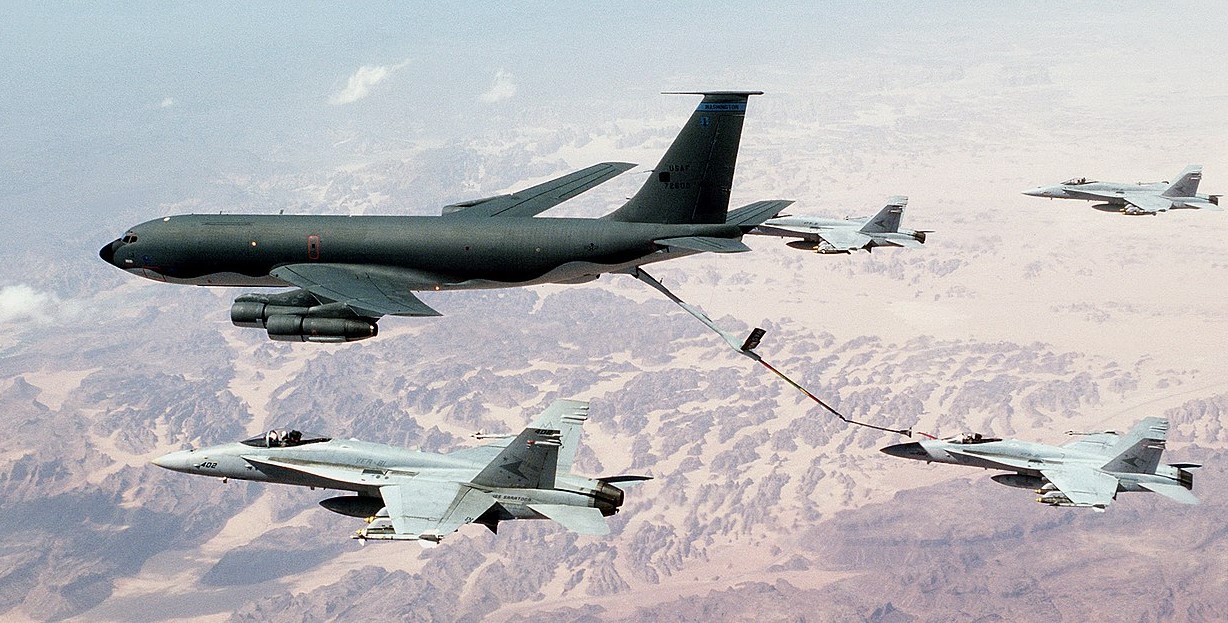
Navy F/A-18s refuel from an Air Force KC-135 during Desert Storm
The Hornet served with distinction throughout the last years of the Cold War, and Kuwait decided to join as a customer in 1988, fearing the threat from Iran. But before its aircraft could be delivered, Kuwait itself became the stage for the Hornet's next combat deployment, when Iraq invaded the country in 1990. During the first night of the air campaign, two Hornets from Saratoga were flying a strike mission, each carrying a quartet of 2,000 lb bombs. They encountered a pair of Iraqi Mig-21s, and after an alert from a nearby E-2, they promptly shot down both Iraqi aircraft before continuing their mission, a powerful demonstration of the ability of the Hornet's multirole capability. Sadly, another Hornet, piloted by Navy Commander Scott Speicher, was shot down by a MiG-25, the most recent American casualty in air-to-air combat. Speicher himself was killed, mostly likely on the ground after ejecting, and his body wasn't recovered until 2009. More broadly, the USN, USMC and Canadian Hornets deployed to Iraq did sterling work, ranging from CAP to deep strike to CAS, and their success undoubtedly contributed to the export orders the Hornet soon racked up.
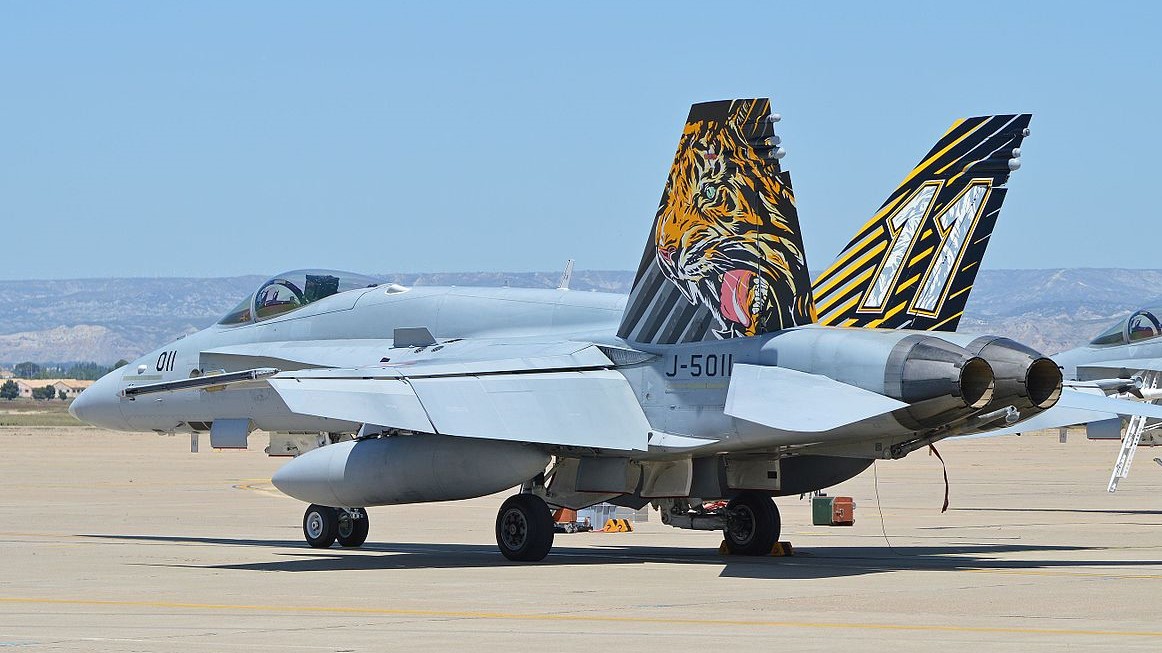
A Swiss Hornet at a Tiger Meet
The delivery of Kuwait's Hornets was slightly delayed by the damage the country suffered at the hands of Saddam's forces, but they were far from the only people receiving the jet in the 1990s. Switzerland had been in the process of buying a new fighter since the late 80s, and the Hornet was declared the winner for the first time in 1988 before the competition was reopened so the MiG-29 could participate, with a second victory coming in 1992 for a total of 34 planes. The cost of the new jet made it controversial, and a public referendum the next year narrowly approved the purchase. The Swiss requested a number of modifications to improve the airplane's performance as an air-defense interceptor, including better engines, a light to allow inspection of aircraft at night, and a reinforced airframe that gave 9G capability and an extended fatigue life.
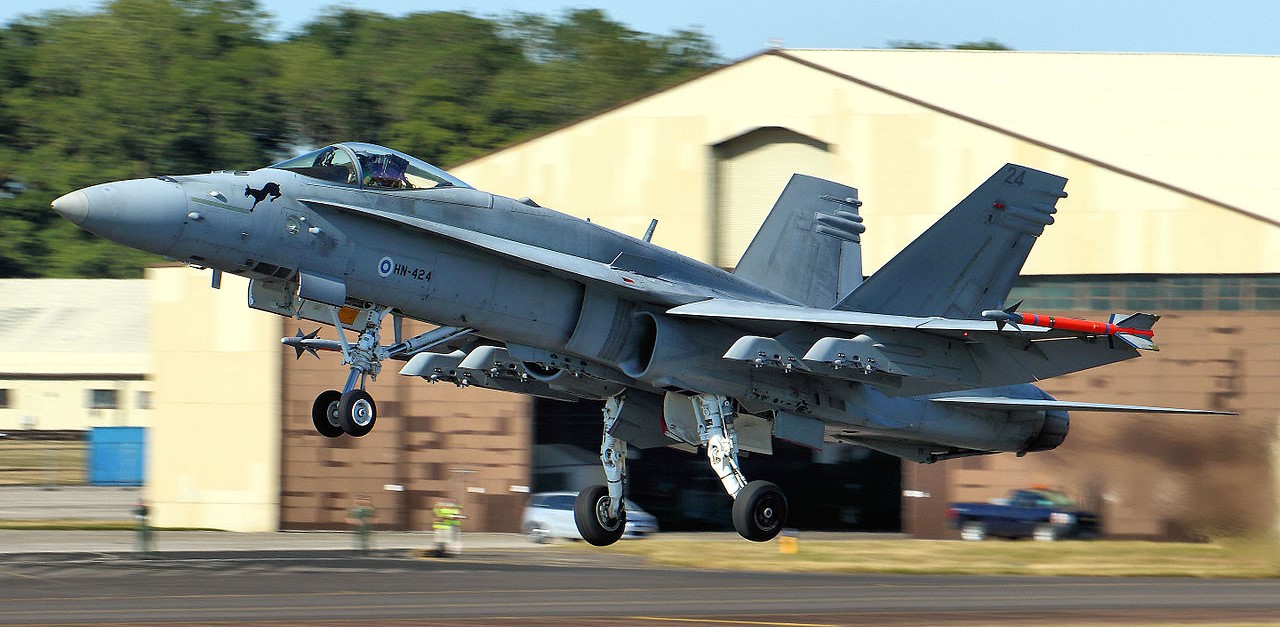
A Finnish Hornet takes off
Finland ordered the Hornet the same year the Swiss did, purchasing 64 airplanes to defend their airspace against Russian incursions. Although the Finns designated their fighters as F-18s, neglecting the ground-attack capabilities for decades, they have recently started to emphasize attack capabilities, dropping bombs after a 70-year hiatus and even buying JASSM. The last purchaser was Malaysia, which bought 8 F/A-18Ds to operate alongside Su-30s, MiG-29s, and BaE Hawks as part of a strategy to buy aircraft from a number of different nations to spread the diplomatic risk around.
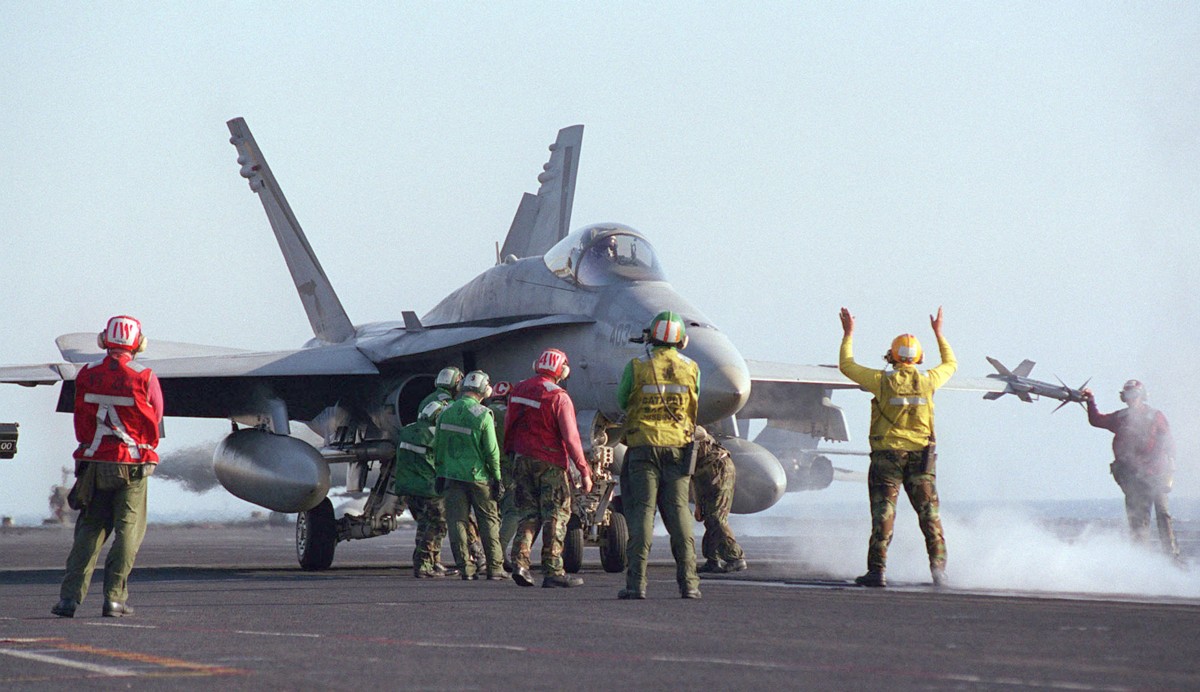
A Hornet of VFA-94 shortly after participating in Operation Desert Fox
The 1990s also saw Hornets in action in two theaters. After Saddam's forces had been pushed out of Kuwait, the UN imposed a no-fly zone over much of southern Iraq, and carrier groups were regularly called upon to help enforce it. While they were rarely challenged in the air, Hornets and other aircraft often dueled with Iraqi air defenses and were occasionally called on to bomb targets when Saddam needed motivation to let in weapons inspectors. Similar things were going on in the Balkans, where the disintegration of Yugoslavia saw NATO spend most of the 90s trying to keep various factions from slaughtering each other over centuries-old ethnic grudges. In addition to Navy F/A-18s flying from carriers, the Marines, Canada and Spain all deployed Hornets to land bases, and the experience prompted a round of systems upgrades, primarily to protect against the SAM systems that littered the area.
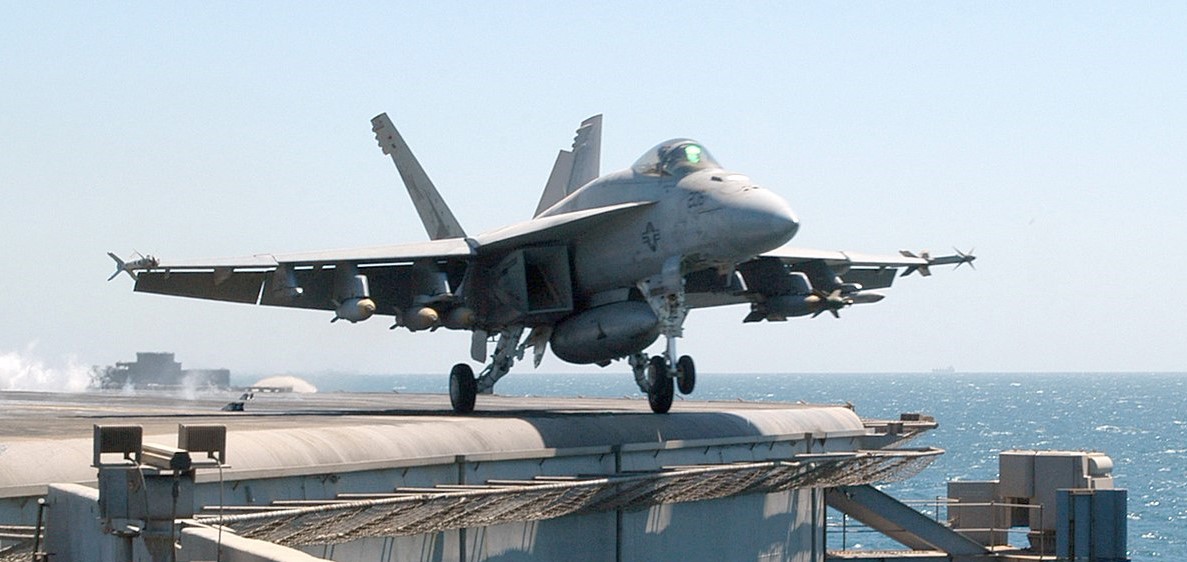
A Super Hornet launches in support of Operation Iraqi Freedom
The new millennium was no respite, despite the general cooling of the Balkans. Operations over Iraq continued, and late 2001 saw Afghanistan added to the mix, with Hornets first taking part in the air campaign that drove the Taliban from power and then helping to provide CAS as NATO ground troops moved in. The Super Hornet made its combat debut over Iraq in late 2002, and both versions participated heavily in the air campaign the next year, with Australia sending some of its jets to aid the coalition.
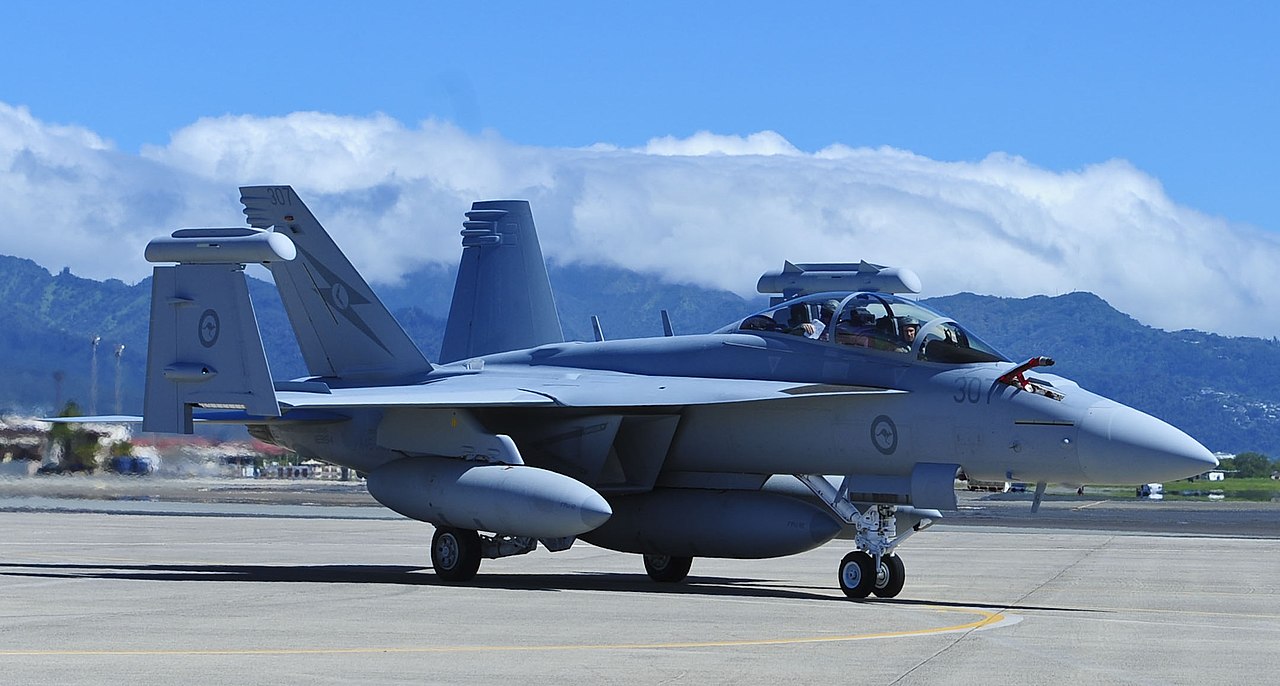
An Australian EA-18G
The Super Hornet has been less successful in the export market than its older brother, with Boeing2 first managing to sell the jet to Australia, which ordered 24 F/A-18Fs in 2007 to replace its F-111s and bridge the gap until the F-35 arrived. Half of these aircraft were wired for later conversion to EA-18Gs, as were many of the USN's F models, but in 2013 the Australian government decided to go ahead and buy 12 new-build Growlers. The only other export order was from Kuwait, which first announced an order in 2015, before backing out in favor of the Eurofighter Typhoon. That deal also fell through, and in 2018, Kuwait signed a contract for 28 Super Hornets, which were delivered in 2021 and 2022. Going forward, it is only likely to be a serious option in competitions where the F-35 is ruled out for diplomatic reasons, and it remains a contender in ongoing procurement efforts in India and Malaysia.
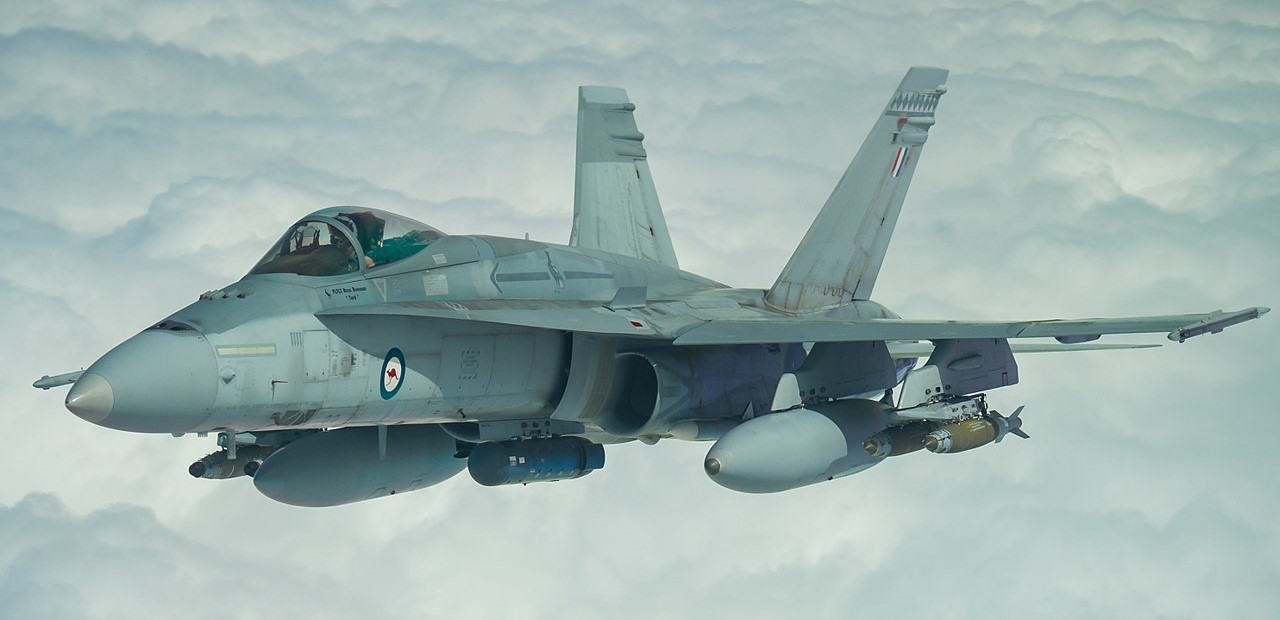
An Australian F/A-18A hauls JDAMs for use against ISIS
Hornets of all types have participated in virtually every American military operation of the last two decades, providing CAS in Iraq and Afghanistan and striking targets in Libya and Syria, often in conjunction with jets from allied nations. In 2017, an F/A-18E shot down a Syrian Su-22, the USN's first air-to-air kill since Desert Storm, first missing with an AIM-9X and then hitting with an AMRAAM. It has also been a major participant in the campaign against the Houthis trying to close the Red Sea, although the highlight was an F/A-18F shot down by Gettysburg.
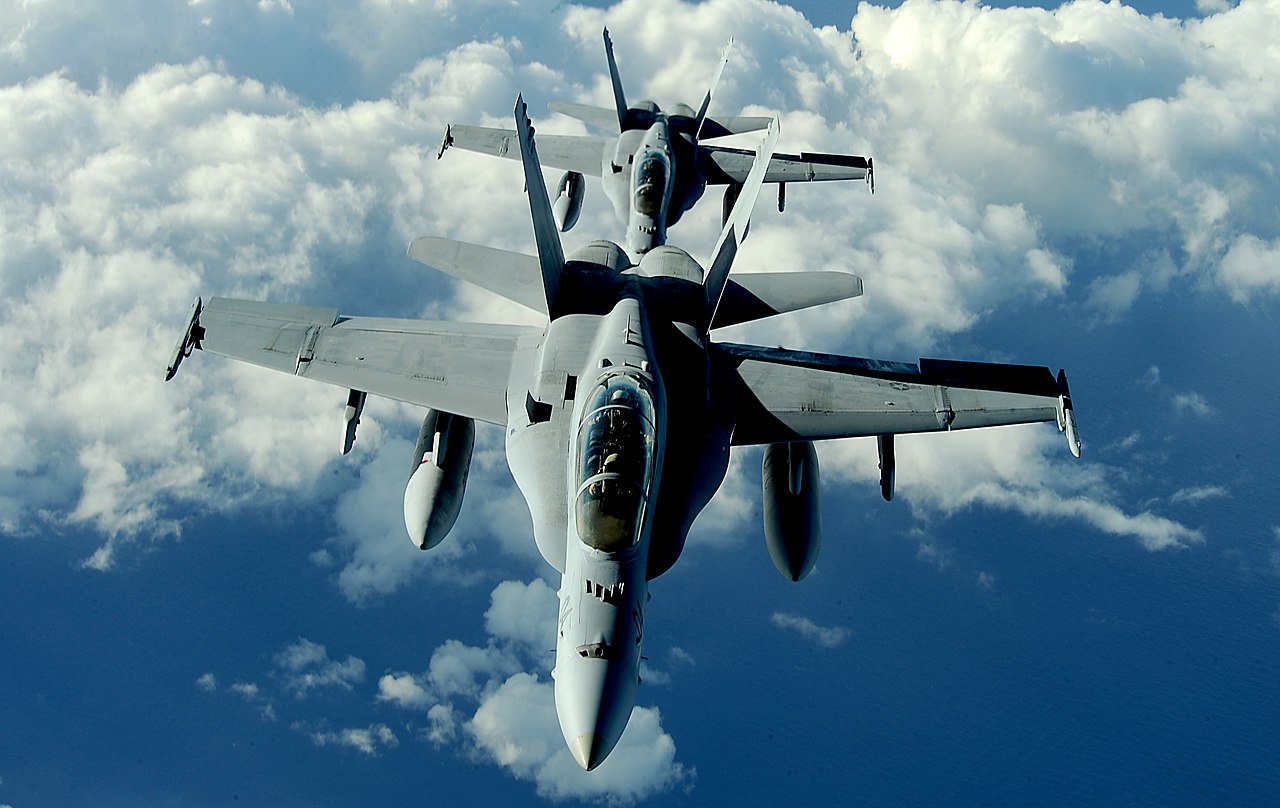
Today, the Legacy Hornet is in the twilight of its career. 2018 saw the last deployment of a USN F/A-18C squadron, and the type was retired from operational USN units the following year. The Blue Angels operated theirs through the 2020 season before transitioning to Super Hornets, modified much as their older planes had been. A few remain in USN service in miscellaneous roles, primarily as adversary aircraft for training. The Marines have kept their Legacy Hornets around while F-35 production spools up, and Marine squadrons continued to deploy aboard carriers thanks to the shortfall in available Navy squadrons until the late 2010s. Australia has also retired its F/A-18As, selling the jets to Canada for spare parts. In the last year or so, Finland, Switzerland and Canada have all signed on to the F-35, leaving Malaysia as the only operator which doesn't currently have a replacement plan in place. The Super Hornet line will be closed down in the next few years, but it and the Growler will be seen on American carrier decks for decades to come.
For more on flying the Hornet, I would suggest looking through the reconstructed archives of Neptunus Lex, a blogger who flew the Hornet for the Navy before passing away during a training crash.

Comments
Regarding Neptunus Lex, I particularily recommend “Rhythms” ( https://thelexicans.wordpress.com/2021/10/17/38223/ )
This series is making me wonder if Ukraine might benefit from some hornets.
How many (non-super, non-growler) hornets are still in US boneyards for possible refurbishment? I’m guessing that some of the same design changes to make a plane rugged enough to land on a carrier might also let it land on rough fields better.
Even if the early hornets aren’t quite as supportive of rough fields as Gripen, perhaps they could handle adapting to their runways being bombed better than F-16s could.
That said, I don’t know how complex hornet maintenance is. Having a reputation for staying in service better than the F-14 still leaves a wide range.
AIUI the Navy Hornets have been picked over for spares by the Marines, just as the RAAF Hornets were picked over by the RCAF. I suspect that there are more low-hours F-16 airframes lying around, in better shape, than F/A-18 airframes. Maybe something could be done with the Finnish or Swiss fleets, if their F-35 deliveries could be expedited, but it's probably a lot easier to just send refurbished F-16s.
@cwillu
Rhythms is excellent, and I don't understand why USNI hasn't gotten the rights to publish it in book form.
@Telnar
Besides the issue that Philistine brings up, there's a longer-term concern as well. A modern fighter takes quite a bit of specialized training on the part of pilots and ground crew, and we'd like to spin the Ukrainians up on as few types as possible. So the focus is going to be on types which they could plausibly operate for at least the next 20 years, and the Legacy Hornet just isn't on that list. It might make sense if there was a plausible Super Hornet buy coming soon given that there is commonality between the types, but I don't think that's in the cards either, given that the Navy keeps trying to shut that line down and there's no clear timetable for when Ukraine might be able to sign a contract. All in all, the F-16 is a better option.
I have also heard that a lot of F-16s have disappeared from AMARG.
Neptunus Lex is sadly missed... :-(
Which brings up the question of why not give the F-35 to Ukraine?
We don't have enough for ourselves, it would be a tremendous logistical burden and it would actually be very escalatory. A lot of things get called escalatory that aren't (sending tanks being the latest) but handing them the world's best strike aircraft would be a very significant step up.
Isn't the bigger problem that those shot down or captured will be studied by the enemy? (and sold to other enemies)
In terms of cost, capabilities, and ease of transition to Ukrainian service, the JAS-39 Gripen would probably be the best fit - but there aren't any to spare, unless the Swedish Air Force has some of the C/D models in flyable storage. I don't think so, but it's possible.
The F-16 is a pretty close second in terms of fit, and there's more than enough to go around. So if the White House will allow it, yeah, the only question is exactly which ones to send from all the possible options.
If the US vetoes F-16 deliveries but Europe insists on sending fighters, then it's going to be some combination of Gripens, Typhoons, and Rafales scrounged from whichever air force doesn't mind being down a squadron or two for the next couple years. Typhoon and Rafale would be logistically complex to transition to Ukraine, I think.
South Korea's FA-50 would also be a good fit, but those would have to be new builds and the ROK isn't just going to donate them, so probably not. Anything else isn't really worth considering, and particularly not US fighters other than the F-16. Either we're going to send F-16s, or we're going to veto US fighters altogether.
Are there any public numbers on sustainment costs for an F-16 vs. F/A-18E/F vs. F-35? Many NATO militaries seem to still be ordering F-16s, and I assume this is driven by cheaper flyaway and sustainment costs. Why is there so much more interest in the F-16 vs. the F/A-18? Is the F-16 just better from a "capability per dollar" perspective for a land-based aircraft?
Are there public numbers? Yes. Are there public numbers you should trust? Not really. There are so many counfounding factors that all we can really say is that the F-35 is more expensive than the other two right now. Cassander can speak to this more.
As for why the F-16 has won out recently, a single engine is almost always cheaper than multiple engines (this is why 4-engine airliners are dead, for instance) and it's the only 4th-gen western fighter that looks to be in support for the next couple decades.
My intuition matches the consensus that F-16 is a better fit than F-15 (cheaper, lower maintenance cost, single engine, likely in production longer...), but to help me understand why it was so obvious that no one mentioned F-15, I'd be interested in seeing those who know more than I do shoot down a devil's advocate case:
US F-15s, while more expensive to produce, are currently being retired at about the same rate as F-16s, so there are some "free" ones. The line, while slower and likely to last fewer years, is still producing the F-15ex, so spares will be available for the length of the war. That 2nd engine and bigger size, comes with more payload and 10% extra speed which could help in dodging near-max range S-400 and R37 fire, allowing F-15s to get a little closer to Russian lines at altitude. If, for whatever reason, the USAF is less interested in keeping F-15s, they might not be that much worse for Ukraine than F-16s.
Off the top of my head, F-15s are very expensive to acquire and operate. They require a lot of fuel (twice as much as an F-16!), a lot of maintenance, and very long runways in good condition. Even if Ukraine could afford F-15s, they probably would have very limited ability to operate them.
It gets worse. The "free" F-15Cs that are being retired now are very old and very tired - the Air Force isn't dumping them because they don't think the plane offers a worthwhile capability, they're shutting them down because there's a real risk that they just start falling out of the sky. No amount of available spares will do enough to help that, short of lifting the serial number up and sliding a new jet underneath, and anyway the spares being manufactured today for the F-15EX are only mostly compatible with the F-15Cs that are going away.
The next problem is that the Ukrainians would really like a multi-role aircraft. Their current primary need is air to air, yes, but in the long term they'd like to be able to operate a single type that is credible against both air and ground targets. The F-15Cs aren't equipped to do air to ground at all, and the F-15Es traded away a fair bit of air to air performance in exchange for greater payload capacity. So F-16 is a better fit than F-15 here, too (though this one is closer, as F-15E with AMRAAM is almost certainly an upgrade over what Ukraine is using right now).
The first thing to remember about aircraft costs is that all numbers about aircraft costs are lies. For example, this is the US military's explanation of how it accounts for aircraft costs: https://imgur.com/a/qt1E9cH. Note, this diagram does not conform with the guidelines in the CAPE14 costs, nor does it conform to the Air Force's or navy's internal breakdowns in the actual data. so all the numbers you see here are highly suspect.
Second, Ukraine can't afford new planes. they're going to have to recapitalize pretty much their whole army after the war so even if they could, in the abstract, afford new fighters, they'll have so many competing demands that it would be a foolish choice to buy them. So they need aircraft that are retiring in relatively large numbers over the next decade or so, and the F-16 is by far the best choice.
There are ~600 F-16s in europe, 300 of which are slated to retire in the next decade. Hundreds more in the US. Many of these will be worn out, but they are still in active production so getting parts is easy. They are the cheapest to operate of any of 4th gen fighters by a pretty wide margin. They are well understood and have upgrade kits available at various levels of cost.
there are ~500 legacy hornets in the world, 300 of which are slated to retire over the next decade. These cost a lot to keep running in US service, nearly double F-16s. They're not dramatically more capable than the F-16s and aren't in active production. They're also mostly very old, and will likely be desired by canada and spain for scrap. They would be a terrible choice.
Super hornets cost less than legacy hornets, only a little more than F-16s, but they're also generally newer. They're more capable than most retiring F-16s and wouldn't be a terrible choice. unfortunately, but the only ones retiring are maybe some of the Block I aircraft in the USN. We have 70 slated for retirement by 2031, but that's a guess.
Legacy F-15s cost about even more to operate than legacy hornets. As @Philistine says, they're set up for Air to Air and are very old. Now, the F-15 airframe is extremely robust, so that's less of a problem than normal, but they're an overly expensive solution.
With typhoons, about 70 tranche 1 aircraft are being retired, but they are largely Air to Air capable. They're also expensive to operate, probably close to F-15 levels. And the T1 is out of production.
Rafales are excellent, very similar to super hornets in cost and capability, but the french will want to get paid. It wouldn't be insane for france to offer the sort of deal they gave to greece, selling off aircraft from French Air Force so they can buy new F4 block fighters, but it would definitely be more costly than F-16s.
as @john schilling said, FA-50s would be a good choice if something new was desired, cheaper to operate than F-16s even, but they'd also need to be bought.
Here are the estimates we made for maintenance cost. This does not include upgrades, or operational costs like fuel. It includes unit level maintainers, but not other unit level personnel. And, again, it's all lies. But they are reasonable and official lies that have a fair bit of work put in to polishing them. They're from late 2021, based on older data. But I'd take them as a good guide.
F-15C/D 24,774 F-16A/B 13,424
F-16C/D 13,221 F-22A 64,744 F-35A 31,462 F/A-18A/B 19,334 F/A-18C/D 20,946 F/A-18E/F 13,913
ugg, formatting
F-15C/D 24,774
F-16A/B 13,424
F-16C/D 13,221
F-22A 64,744
F-35A 31,462
F/A-18A/B 19,334
F/A-18C/D 20,946
F/A-18E/F 13,913
@Cassander
Thank you for the maintenance numbers. They make clear how stark the relative differences are. I wasn’t sure what units they were in, though. The numbers seem too high to be thousands of dollars per plane per year, and I didn’t have a good 2nd guess.
@Telnar, I believe the units are per flight hour, as the imgur link was CPFH.
Noob question: When it's said that f15s - or in the first installment of this series: F14s - can't do ground attack like a F16 can; what does this actually mean?
AIUI, a F16 is a much smaller aircraft than the F14 or 15, so can it still haul a lot more stuff to be directed towards the ground? Or is this a matter of integrated instrumentation required to actually hit anything?
@Doctorpat,
A little Column A, a little Column B. There are three problems, AIUI.
One: if the weapons employment computers on your airplane aren't set up to talk to guided bombs and air-to-ground missiles, you're limited to free-fall weapons at best - which you'd be aiming by eye, instead of using any kind of advanced bomb aiming system, because a modern aircraft with an advanced bomb aiming system would also almost certainly be set up to talk to guided bombs and missiles. This was the case for the F-14 for most of its service life in the USN, and is still the case for the F-15C.
Two: nobody will spend the time and money to test carriage and release for weapons types that a given aircraft type is never expected to employ. This is a bigger deal than you might think - certainly its a bigger deal than I used to think - because nobody wants a weapon that's been released to get caught in an aircraft's slipstream and fail to drop. For example. This was the case for the F-14 for most of its service life in the USN, and is still the case for the F-15C.
And three: Every weapons station on every aircraft has size and weight limits on what weapons can be carried there. The F-14 was able to carry bombs on its two wing glove pylons and also on its four under-fuselage stations, giving it a pretty respectable payload once the other issues had been sorted out; the F-15C has only two under-wing weapons stations on which bombs could even theoretically be hung, giving it an effective air-to-ground payload somewhat less than the F-16, even if the type's other deficiencies as a ground attack type were corrected.
The Navy did eventually turn the F-14 into a reasonably good bomber toward the end of its career. When the USAF wanted F-15s to carry bombs, they built F-15Es and retained the F-15Cs for the purely air-to-air mission.
I don't have much to add to what Philistine said here. The first issue was a very serious problem when the F-14 and F-15 entered service (the Hornet was really the first plane with good capability at both), and the USAF has never spent the money to fix it on the F-15C.
Is the target detection hardware also an issue? I mean besides obviously different software, can the same sensors be equally effective vs tanks and jet fighters?
Yes, although less so now than it once was. In the olden days, radars had to be specialized to their tasks, so planes could basically do one or the other. Modern radars are fully capable in multiple modes, although radar isn't really the primary ground-attack sensor. That's probably the targeting pod, which isn't generally carried by air-to-air planes.
That makes things clear.